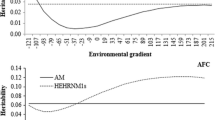Abstract
The multi-trait reaction norm (MTRN) model was extended to beef cattle reared under tropical conditions with the following objectives: to compare multi-trait (MT) and MTRN models regarding the genetic parameters obtained; and to characterize G × E, the pattern of phenotypic expression, and the environmental sensitivity of animals for postweaning weight gain (PWG), scrotal circumference (SC), and annual average productivity of the cow (PRODAM). There was divergence in the estimates between the MT and MTRN models when the posterior probability intervals of additive genetic variances and heritability coefficients of PWG and PRODAM were analyzed. The MTRN model indicated an increase in heritability for PWG and PRODAM with improvement of the environmental conditions. For SC, heritability was practically the same, irrespective of the environmental conditions. The genetic correlations between the traits studied were low but varied over environments by the MTRN model. Considering genetic correlations obtained by the MTRN model for the same trait, lower estimates were obtained between extreme favorable and unfavorable environments. This finding suggest re-ranking of breeding values in different environments mainly for PWG and PRODAM. Thus, G × E is more important for PWG and PRODAM than for SC and should be included in the genetic evaluation of these traits. The traits PWG and PRODAM can be considered plastic traits, whereas SC is poorly plastic. The genetic trends in individual animal slopes indicate that the population is moving towards greater plasticity. This could be a matter of concern for breeders since greater plasticity seems to limit heritability and, consequently, the responses to selection.




Similar content being viewed by others
References
Cardoso FF, Tempelman RJ (2012) Linear reaction norm models for genetic merit prediction of Angus cattle under genotype by environment interaction. J Anim Sci 90:2130–2141
Corrêa MBB, Dionello NJL, Cardoso FF (2009) Genotype by environment interaction characterization and model comparison for post weaning gain adjustment of Devon cattle via reaction norms. R Bras Zootec 38:1460–1467
de Jong G (1995) Phenotypic plasticity as a product of selection in a variable environment. Am Nat 145:493–512
Eler JP, Silva JAIIV, Evans JL, Ferraz JBS, Dias F, Golden BL (2004) Additive genetic relationships between heifer pregnancy and scrotal circumference in Nellore cattle. J Anim Sci 82:2519–2527
Eler JP, Ferraz JBS, Balieiro JCC, Mattos EC (2008) Genetic analysis of average annual productivity of Nellore breeding cows (COWPROD). Genet Mol Res 7:234–242
Falconer DS (1952) The problem of environment and selection. Am Nat 86:293–298
Kolmodin R, Bijma P (2004) Response to mass selection when the genotype by environment interaction is modelled as a linear reaction norm. Genet Sel Evol 36:435–454
Lopes JS, Rorato PRN, Weber T, Boligon AA, Comin JG, Dornelles MdA (2008) Genotype and environment interaction effect on weights at birth, 205 and 550 days of age of Nellore cattle in the South Region of Brazil. R Bras Zootec 37:54–60
Mattar M, Silva LOC, Alencar MM, Cardoso FF (2011) Genotype × environment interaction for long-yearling weight in Canchim cattle quantified by reaction norm analysis. J Anim Sci 89:2349–2355
Menéndez-Buxadera A, Mandonnet N (2006) The importance of the genotype × environment interaction for selection and breeding programmes in tropical conditions. CAB Rev: Perspect Agric Vet Sci Nutrition Natural Resources 1:026
Misztal I, Tsuruta S, Strabel T, Auvray B, Druet T, Lee DH (2002) BLUPF90 and related programs (BGF90). In: Proceedings of the 7th World Congress on Genetics Applied to Livestock Production, Montpellier, France, 19–23 August 2002
Morales R, Menéndez-Buxadera A, Avilés C, Molina A (2013) Direct and maternal genetic effects for preweaning growth in Retinta cattle estimated by a longitudinal approach throughout the calving trajectory of the cow. J Anim Breed Genet 130:425–434
Nephawe KA, Neser FWC, Roux CZ, Theron HE, van der Westhuizen J, Erasmus GJ (1999) Sire x ecological region interaction in Bonsmara cattle. S Afr J Anim Sci 29:189–201
Pégolo NT, Oliveira HN, Albuquerque LG, Bezerra LAF, Lôbo RB (2009) Genotype by environment interaction for 450-day weight of Nelore cattle analyzed by reaction norm models. Genet Mol Biol 32:281–287
Pigliucci M (2005) Evolution of phenotypic plasticity: where are we going now? Trends Ecol Evol 20:481–486
Santana ML Jr, Eler JP, Bignardi AB, Ferraz JBS (2013a) Genetic associations among average annual productivity, growth traits, and stayability: a parallel between Nelore and composite beef cattle. J Anim Sci 91:2566–2574
Santana ML Jr, Eler JP, Cardoso FF, Albuquerque LG, Ferraz JBS (2013b) Phenotypic plasticity of composite beef cattle performance using reaction norms model with unknown covariate. Animal 7:202–210
Tonsor SJ, Elnaccash TW, Scheiner SM (2013) Developmental instability is genetically correlated with phenotypic plasticity, constraining heritability, and fitness. Evolution 67:2923–2935
Windig JJ, Calus MPL, Beerda B, Veerkamp RF (2006) Genetic correlations between milk production and health and fertility depending on herd environment. J Dairy Sci 89:1765–1775
Windig JJ, Mulder HA, Bohthe-Wilhelmus DI, Veerkamp RF (2011) Simultaneous estimation of genotype by environment interaction accounting for discrete and continuous environmental descriptors in Irish dairy cattle. J Dairy Sci 94:3137–3147
Acknowledgments
We are grateful to CFM-Leachman Pecuária Ltda. for providing the data set. This work was funded by Fundação de Amparo à Pesquisa do Estado de Mato Grosso (FAPEMAT).
Author information
Authors and Affiliations
Corresponding author
Rights and permissions
About this article
Cite this article
Santana, M.L., Eler, J.P., Bignardi, A.B. et al. Multi-trait linear reaction norm model to describe the pattern of phenotypic expression of some economic traits in beef cattle across a range of environments. J Appl Genetics 56, 219–229 (2015). https://doi.org/10.1007/s13353-014-0242-9
Received:
Revised:
Accepted:
Published:
Issue Date:
DOI: https://doi.org/10.1007/s13353-014-0242-9




